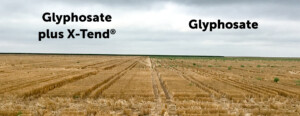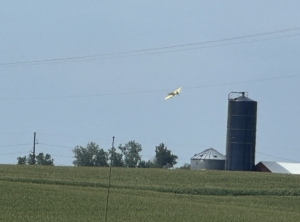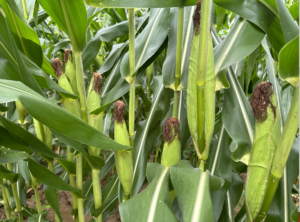Yellow airplanes were buzzing over Iowa cornfields like bumblebees over zinnias during my drive to Iowa last week. There was a time when Midwest farmers would grind their teeth at the sight of these crop dusters. It usually meant a neighbor was treating a pest problem with a costly, unplanned aerial application. And that pest problem was heading their way. My how times have changed.
Nowadays, foliar fungicide applications are SOP for many corn and soybean growers. A retailer in Iowa told me two-thirds of his customers make planned fungicide applications. Regardless of there being visible signs of fungal pressure, fungicides are seen as providing crop health benefits that lead to a yield bump. Seed company research shows a 7-bushel increase for corn and 3 bushels for soybeans. The best bang for your buck comes when fungicides are applied during pollination in corn and pod development in soybeans. The idea is to mitigate any potential stress factors. And for good measure, many savvy growers maximize the flight by adding foliar fertilizer and growth managers to the tank. I’ve long believed that foliar fungicide applications can be the easiest money a farmer makes. That’s why I applied Huma Gro® Proud 3® and Crop Gard® to my R1 corn and spiked it with Breakout® and foliar fertilizers. Huma offers a variety of natural foliar fungicides that provide a yield bump while lowering CI scores.
My corn is at the R3 stage. Lots of the ears are producing 18 rows (rounds). The tips are not filled out, which is likely due to high heat during pollination. And I have not irrigated (nor will I this season). But I’m still counting many rows with 38 kernels. The ear shown below is fairly representative of what I’ve seen scouting. You’ll find bigger and smaller ears, but this is typical. Now it’s about adding weight to those kernels.
We know regenerative agriculture is good for the soil, good for the environment, and good for crops. But studies suggest that regen ag may be just as good for our diets. Scientists at Unilever found that practices which increase soil organic matter also increased the zinc content of rice, while tomatoes grown under deficit irrigation produce greater levels of vitamin C. Yet it’s not just cultural practices that lead to greater nutritional content. While limited in scope, studies are suggesting that adding natural biostimulants like humic acid to the soil can increase iron and zinc levels in wheat.
I often wonder why do companies care more about the opinions of people who will never buy their products than those who do? Well, at Huma, our purpose is to “enhance the quality of life by empowering others with sustainable humic substances.” This certainly helps us identify and support like-minded partners and customers. It also helps steer us toward movements such as soil health and regenerative agriculture.
Related Posts

BHN’s Fertilgold® Organics Earns OMRI-Listing for 21 Products
Fertilgold® Organics, a brand of organic fertilizer products from Bio Huma Netics, Inc. (BHN) headquartered in Gilbert, Ariz., has achieved Organic Materials Review Institute (OMRI) listing for 21 initial products. Of these, 13 OMRI-listed liquid crop nutrition products are based on the company’s proprietary nutrient carrier, Micro Carbon Technology®, which carries nutrients to plants more

Earth Day: “It’s Getting Better All the Time”
Celebrating Earth Day every April 22 is a great time to pause and reflect: How are we, today, treating the environment and the plants, animals, and people who live in it? What have we accomplished in the past year that makes our planet a better, more sustainable place to live and raise our families? What are our goals for future improvement?

Field Trial: X-Tend® Increases Glyphosate Effectiveness
Objective Over the years, some weeds have developed resistance to common herbicides such as glyphosate. To overcome this hurdle, growers may bump up the rates or add other herbicides or products with different mechanisms/modes of action into the tank mix. Such approaches have had mixed results over the long run and have increased the cost




